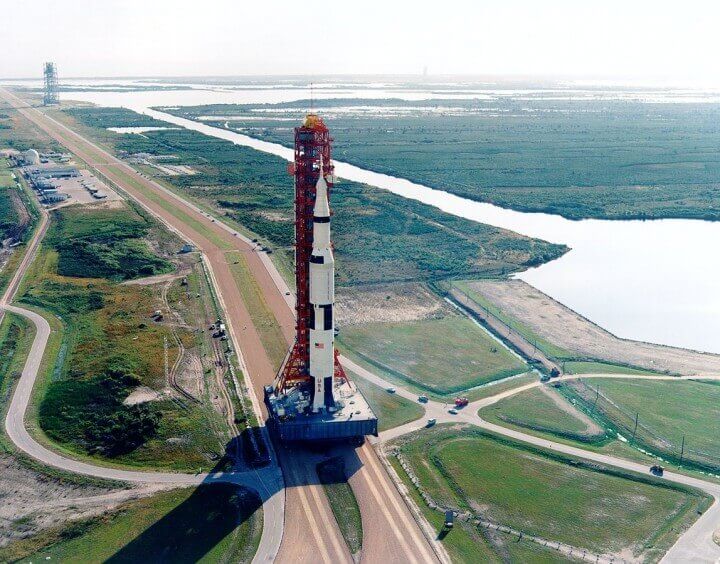- The Second Human Spaceflight:
Apollo 8 was the second human spaceflight. The first human spaceflight was launched by the Soviet Union on April 12, 1961. Apollo 8 was launched on December 21, 1968. Apollo 8 was the first human mission, in which the spacecraft left the Earth’s orbit. It was the first manned mission to orbit the moon.
- The Astronauts:
There were three astronauts aboard Apollo 8: Commander Frank Borman, Command Module Pilot James Lovell, and Lunar Module Pilot William Anders. They were the first humans to see Earth as a whole planet, first humans to see Earthrise, and the first to see the far side of the moon. The crew orbited the moon, but did not actually land on the moon. James Lovell would go on to be the commander of Apollo 13. Frank Borman and James Lovell were both members of the 1965 Gemini 7 crew.
- The Good Book:
On Christmas Eve, 1968, Apollo 8 entered the lunar orbit. That evening, the crew broadcasted photos and observations from the spacecraft. The crew took turns reading the first ten verses of Genesis. They circled the moon ten times that night. At the time, the broadcast was the most watched broadcast ever!
- “Roger, please be informed there is a Santa Claus.”
On Christmas morning, the crew headed back home to Earth. Mission Control waited excitedly to hear from the crew of Apollo 8 that their engine burn had worked and they were returning home. Mission Control lost contact with Apollo 8 for over 89 hours before Jim Lovell would make a long-awaited, now famous radio transmission. Jim Lovell communicated the famous words, “Roger, please be informed there is a Santa Claus.”
- Three Days Travel:
Apollo 8 lifted-off from the Kennedy Space Center, near Cape Canaveral Air Force Station. It took the Apollo 8 crew three days to get to the moon. They circled the moon about ten times in the matter of 20 hours, and then prepared for their return to Earth. The original mission was to take place in early 1969, but was pushed up months sooner, when it was determined that the lunar module would not be ready in time. Instead, the mission was rescheduled to proceed without the lunar module. It was a 590,000-mile voyage and the total trip time was 7 days, or 147 hours, 0 minutes, 42 seconds.
- The Mission:
President John F. Kennedy had expanded the space program in 1961, in an effort to land a man on the moon by the end of the decade.The main goal of the Apollo 8 mission was to test equipment and ultimately, was for preparation of having later missions land on the moon. One of the tasks performed by the Apollo 8 crew was to photograph the moon’s surface, make visual observations about the moon. Many photographs were taken during the orbit around the moon. These photographs were used to update existing maps and charts. Many of the photographs are in black and white. The reason for this is that the resolution and clarity of the black and white photos was better than that of color photographs.
- The Spacecraft:
Apollo 8 was very similar to Apollo 7. The main difference was that the forward pressure and ablative hatches were replaced by a combined forward hatch. Also, there were couches added for the comfort of the crew. There was no lunar module on Apollo 8; however, there was a test module was mounted that was similar in mass to the lunar module. This was done to verify that the lunar module could be stabilized for travel on future explorations.
- Testing. Testing. Testing.
The Apollo program consisted of many test missions, which were manned and unmanned. There were 12 manned test missions and several unmanned test missions. Of those 12 manned missions, 6 missions landed on the moon (Apollo 11, 12, 14, 15, 16, and 17). Only two astronauts on each of the 6 missions walked on the moon. Additionally, there were 3 missions that orbited the Earth (Apollo 7, 9 and Apollo-Soyuz), two missions that orbited the moon (Apollo 8 and 10), and one lunar swing-by—the infamous Apollo 13 mission.
- Faster than a Speeding Bullet:
Apollo 8 New world set a new world speed record in 1968, clocking speeds equal to 24,200 miles per hour (38,938 km/hr). At liftoff, the five-first engines of the Apollo 8 spacecraft converged together in a 7.5 million pound thrust, to propel Apollo 8 out of the Earth’s atmosphere. The Apollo 8 stood on top of the Saturn V rocket at 363 feet (110 meters) tall.
- Splash Down!
Splash down refers to the water landing of a spacecraft into the ocean or body of water. The Apollo 8 capsule parachuted into the ocean on December 28, 1968 at 10:51:42 a.m. EST. Apollo 8 landed in the Pacific Ocean. The crew and spacecraft were picked up at sea, by the USS Yorktown. The practice of parachute landings into water was common practice until the Space Shuttle Program in 1972.


Leave a Reply